Histopathological Effects of Cannabis on the Heart and Brain of Winster Rats
Nkporbu AK1* and Georgewill O2
1Department of Neuropsychiatry, University of Port Harcourt Teaching Hospital, Nigeria
2Department of Pharmacology, University of Port Harcourt, Nigeria
Submission: February 01, 2023; Published: February 20, 2023
*Corresponding author:Nkporbu AK, Department of Neuropsychiatry, University of Port Harcourt Teaching Hospital, Nigeria
How to cite this article:Nkporbu AK and Georgewill O. Histopathological Effects of Cannabis on the Heart and Brain of Winster Rats. J of Pharmacol & Clin Res. 2023; 9(2): 555756. DOI: 10.19080/JPCR.2023.09.555756
Abstract
Background: The central nervous system (CNS) physiological effects of cannabis have been extensively studied. However, very little is known about the histopathological changes in the heart and brain both in short time and chronic cannabis users. In this study, toxic effects of cannabis on the heart and brain of rat were investigated.
Aim: The study aimed to investigate any dose dependent toxic effects on the heart and brain of rats.
Methodology: Thirty (30) rats with average weights 150-200g were used for the study. The animals were divided into groups A, B, C and D. They were all acclimatized for 5 days and fed on the same feed. Animals in groups B to D were administered with different doses of cannabis-with Group D- the highest dose-4Omg/kg/day, Group C-20mg/kg/day and Group B-l0mg/kg/day. These doses were chosen mainly from extensive literature review. Group A was used as the control. The cannabis substance was administered to the rats daily for 28 days in the laboratory in addition to their usual daily feeds and water. The animals from the different groups were sacrificed on days 7,14,2 1, and 28. The brain and heart were excised after dissecting the rats and the tissues were collected for histology.
Results: From the study, the animals were observed to have increased agitation, restlessness, and violent tendencies within 20-30 minutes after each administration which was dose dependent. Interestingly, gradual weight loss was observed in the experimental animals as against the Control group on the last week of the experiment. A dose dependent increased duration of sleep was also observed in the experimental animals but not in the Control group. No structural changes were observed in the heart while in the brain, inflammatory changes were observed.
Conclusion: This study showed no structural changes in the heart after administration of cannabis for the study period. This may suggest that although cannabis has been strongly associated with panic attack, it may not cause any structural damage to the heart membrane, musculature, and vasculature. However, the study has revealed that, in addition to issues of intoxication, cannabis can also produce histopathological damage to the brain. I therefore recommend that in addition to advice based on intoxication as reasons for abstinences, possible damage to brain tissues should also be given as reasons for abstinence and furthermore treatment of cannabis abuse should also involve possible investigations and treatment of brain damage.
Keywords: Histopathological; Cannabis; Heart; Brain; Rats
Abbreviations: CNS: Central Nervous System; CBG: Cannabigerol; CBC: Cannabichromene; CBD: Cannabidiol; THC: Tetrahydrocannabinol; CBL: Cannabicyclol; CBE: Cannabielsoin; CBN: Cannabinol; CBND: Cannabinodiol; CBT: Cannabitriol; GP: Globus Pallidus; CB1R: Cannabinoid 1 Receptor
Introduction
Cannabis is the second most commonly smoked substance after tobacco, with an estimated 160 million users (3.8% of the world’s population of 15–64-year-olds) Adamson [1], Nsikak & Godwin 2019. Different plant substances produce specific pharmacological effects on humans Ashton [2], Berham [3]. Such effects may alter the normal physiological functions of the body, and even greater alteration at toxic levels Rajput [4]; Akinola [5]. Such alterations may include respiratory difficulty, changes in cardiac function, impaired renal functions and an altered perception. Cannabis consumption is also associated with a number of psychological effects in humans Thornicroft [6]; Borofka [7]; Louise [8]; Patton [9]; Odejide [10]; Stanley & Eneh [11]; MacFadden [12]; Zou & Kumar [13], although some researchers have argued about cannabis medicinal use Blanchard [14]; Gurley [15]; Hubbard [16]. Inspit of theses, the regulations for cannabis use have not been very effective Obot [17]. Cannabis specifically refers to the green, brown, or gray mixture of dried, shredded leaves, stems, seeds, and flowers of the cannabis plant; it’s called Marijuana (Nsikak and Godwin, 2019). Cannabis exists in three forms: herbal cannabis, the dried leaves, and flowering tops Munro [18]. The resin of the cannabis is the pressed secretions of the plant, known as ‘hashish’ or ‘charash Ujah [19]; Rajput & Kumar [4]. It contains diverse phytochemicals of biological activities and therapeutic influence, such as cannabinoids, terpenes, and phenolic compounds Hillig [20]. Cannabinoids is the most therapeutic compounds, because of its wide range of pharmaceutical effects in humans, including psychotropic activities Hillig [20]; Rajput & Kumar [4].
The raw plant material contains essential fatty acids, nine essential amino acids, dietary fiber, enzymes, vitamins, minerals, flavonoids, carotenoids, terpenes, and Phyto cannabinoid acids a Hillig [20]; Ujah [19]; Rajput & Kumar [4]. Raw cannabis leaves, stems, stalks, and seeds can provide the body with almost all of the essential nutrients including carbohydrates, protein, fat, water, vitamins, minerals, trace amounts of calcium, sodium, potassium, and omega-3 fatty acids Audu [21], Ujah [19] reported presence of alkaloids, flavonoids, cardiac glycosides, resins, tenpins and steroids while the proximate composition had elevated levels of 6.87% moisture, 23% crude protein, 19.97% lipid and 11.8% Ash; 18.95% fiber and 39.70% NFE in the stem and 25.36% crude fiber content in seeds. C. sativa leaf contains 9 Essential Amino Acids (EAA), which have good concentration of methionine and lysine. Oladimeji & Valan [22] reported the presence of Alkaoid, flavonoids, cardiac glycosides, terpenes & steroids, and resins. Also, presents were Cannabigerol (CBG), Cannabichromene (CBC), Cannabidiol (CBD),’9-Tetrahydrocannabinol (THC), ‘8-THC, Cannabicyclol (CBL), Cannabielsoin (CBE), Cannabinol (CBN) and Cannabinodiol (CBND), Cannabitriol (CBT) Choudhary [23]. The most common route of consumption of Cannabis is smoking a cigarette (Nsikak and Godwin 2019). In contrast, others use it as an ingredient in foods, and are made available as beer. Two cannabinoid receptor systems; cannabinoid 1 receptor (CB1R) in the brain specific for Δ9-THC and cannabinoid 2 receptor (CB2R) are situated in the brain Onaivi [24]; Schweitzer [25]; Zou & Kumar [13]. The CB1Rs are located in the brain, particularly in the substantia nigra, the basal ganglia, limbic system, hippocampus, and cerebellum Pertwee [26]; Zou & Kumar [13]. The CB2Rs are expressed significantly in immune cells, spleen, and the gastrointestinal system, and to some extent in the brain and peripheral nervous system Chen [27]; Rodrigues [28]. A report revealed that Cannabis exposure result in impairments of executive function, including reversal learning, set shifting, and delayed match- and non-match-to-sample working memory tasks Chait & Zacny [29]; Gardner [30]; Ashton [2]; Berham [3]; Cohen & Weinstein [31].
Akinola [5] reported the neurobehavioral effects of daily oral ingestion of C. sativa and its modulatory changes in oxidative stress parameters in mice brain tissues in a study where neurobehavioral activities were assessed by observing animals rearing, grooming, ambulation, head dipping and freezing times. The animals fed with cannabis-diet displayed significantly reduced anxiety but statistically insignificant locomotory function, exploratory tendencies and neophilia, in a quantity dependent manner relative to the controls. Cannabis demonstrated both antioxidant and oxidative stress tendencies. Kim et al., (2019) reported that regular cannabis use can alter brain function, especially in networks that support working memory, attention, and cognitive control processing Chait & Zacny [29]; Gardner [30]; Ashton [2]; Berham [3]. The hippocampus and caudate nuclei specifically showed aberrant structural and functional coupling. These structures have high CB1 receptor density and may also be associated with changes in learning and habit formation that occur with chronic cannabis use. In addition to the physiological alteration, at normal or otherwise toxic levels, some zenobiotics can cause direct structural affectation and/or minor or major histological changes to tissue and organs of the body Awolabi [32]. Control/regulations for cannabis use is still relatively in effective in many countries Obot [17]. In spite of all these, a number of studies have laid claims to the medical usefulness of cannabis Blandchard [33]; Hollister [34]; Hubbard [16]. Cannabis is a genus of flowering plant that belongs to the kmgdom-plantae, division magnolioghyta, class magnohopsidea, order Rosales, family-cannabareae Hangman [35]. Cannabis has three putative species, cannabis sativa Linnaeus subsp. Indica L., Cannabis sativa subsp. Sativa, L. (cannabis sativa information, 2008), and Cannabis ruderalis Janiseh Berham [3]; Booth [36]; Audu [21]. These three Texas are indigenous to central Asia and surrounding regions. C. Rucleralis is commonly described as ‘auto- flowering and may be day-neutral. Various strains of cannabis have been identified and although there are hundreds of strains of cannabis in existence, there are also many rumors and urban legends (Hirsch et at., 1997; Short D.J. 1990).
All known strains of cannabis are wind-pollinated Clark et al, 1991; Ainsworth [37] arid produce ‘feed’ that are technically called achenes. Most strains of cannabis are short day plant (Clark et al., 1991) with the possible exception of Cannabis sativa subsp. Saliva var. Spontanea (=C. ruderalis). Cannabis is an annual dioecious, flowering herb. The leaves are palmately comp and, with serate leaflets. The quality and potency of cannabis depend on a number of factors; the part of the plant, the planet, the soil Cultivation and method of preparation Pertwee [26]; Ujah [19]; Oladimeji & Valan [22]. The psychoactive potency of cannabis plant is approximately as follows (descending order), Trichomes, Female flowering buds, Male flowering buds, new shoots, leaves from flower buds, leaves in ascending order of size, Stems of leave (petioles) in ascending order of size, Stem in ascending order of size, Roots and seeds. The potency of herbal cannabis decreases over time in storage and is affected by what parts of the plant have been included in the product Chen [26]; Zou & Kumar [12]. Hence, a user has little guarantee about the intensity of the high Anthony and Heizer [38]; Beautrais [39]; Higuera-Matas et al, 2009; Ujah [19]; Broyd [40]; Cohen [41]; Cohen & Weinstein [31]; Choudhary [23]. The central nervous system (CNS), particularly the limbic system constitutes the center of emotion and appears to be the pharmacodynamic target of cannabis. The pirncipal component of cannabis is A9 THC, however, the cannabis plant contains more than 400 chemicals, of which about 60 are chemically related to A9 THC. In humans, A-THC is the metabolite that is active in the central nervous system (CNS). Specific receptors for the cannabinols have been identified, cloned and characterized Friedman H [42]. The distribution of cannabinoid receptors in rats is similar to that of humans Munros S [18] The receptor is densely present in the hippocampus, globus pallidus (GP), basal ganglia, the perventricular nucleus, the substantial nigra, pars reticulata, and the cerebellum. Binding of tritiated ligand is moderate in the cerebral cortex and the caudate, putamen and sparse in the brainstem and spinal cord. This probably explains the reduced tendency of cannabis to cause respiratory depression even with an intoxicating dose as well as reduced cardiac effects. Studies in animals have shown that the cannbinoids affect the monoamine and y-aminobutyric acid (GABA) neurons.
When cannabis is smoked, the euphoric effects appear within minutes, peak in about 30 minutes, and last 2 to 4 hours. Some motor and cognitive effects last 5 to 12 hours. Cannabis can also be taken orally when it is prepared in food, such as brownies and cakes. About two to three times as much cannabis must be taken orally to be as potent as cannabis taken by inhaling its smoke. Many variables affect the psychoactive properties of cannabis, including the potency of the cannabis used, the route of administration, the smoking technique, the effect of pyrolysis on the cannbainoid content, the setting, the user’s past experience, the user’s expectations, and the user’s unique biological vulnerability to the effects of cannabinoids. Apart from its blood vessels and some neuroglial elements, the whole of nervous system is derived from the ectoderm. The part of the ectoderm that is determined to give origin to the brain and spinal cord. The limbic system which constitutes the centre of emotion appears to be the pharmacodynamic target of cannabis. This system (the rewards system of the brain) is not precisely defined anatomically and has been implicated in functions such as emotion and memory. This definition includes the following cortical areas (the limbic cortex) the cingulate, parahippocampal and subcallosal gyri These structures surround the upper brain stem Subcortical nuclear groups embraced in this system include the amygdaloid body (nucleus) and the septal area. The central nervous system (CNS) physiological effects of cannabis have been extensively studied Higuera-Matas et al, 2009; Ujah [19]; Broyd [40]; Cohen [41]; Cohen & Weinstein [31].
However, very little is known about the histopathological changes in the brain and other important organs of both short time and chronic cannabis users Awolabi [32]. In this study, toxic effects of cannabis on the heart and brain of rat were investigated. This study therefore aimed to investigate any dose dependent toxic effects on the heart and brain of rats.
Objectives
a) To examine the possible histopathological effect of cannabis on the brain and heart of rats.
b) To determine any dose dependent effects of cannabis on these tissues.
c) To find out any alteration in the histological architecture of the brain and heart of rat using histopathological examination.
Methodology
Thirty (30) rats with average weights 150-200g were used for the study. The animals were divided into groups A, B, C and D. They were all acclimatized for 5 days and fed on the same feed. Animals in groups B to D were administered with different doses of cannabis—with Group D— the highest dose—4Omg/kg/ day, Group C—20mg/kg/day and Group B—l0mg/kg/day. These doses were chosen mainly from extensive literature review. Group A was used as the control. The cannabis substance was administered to the rats daily for 28 days in the laboratory in addition to their usual daily feeds and water. The animals from the different groups were sacrificed on days 7,14,2 1, and 28. The brain and heart were excised after dissecting the rats and the tissues were collected for histology.
Results
Effect of Cannabis on Weight
From the study, it was observed that the rats gained weight in the first and second weeks, but most of the rats lost some weight in the last week of the experiment. The later observation was not noticed in the rats in group C that receive the lowest dose as well as in the control animals.
Effects of Cannabis on the Histology of the Brain
Figure1 & Figure 2a,b,c below show the photomicrographs of the brain of animal from test group D (Highest dose) on the day 7 of the experiment, showing infiltration of the outer cortex by acute inflammatory cells and around blood vessels. Similar observation was made in group C on day 14. See Figure 3a,b,c Interestingly, no abnormality of changes was seen on the histology of the heart throughout the experiment.
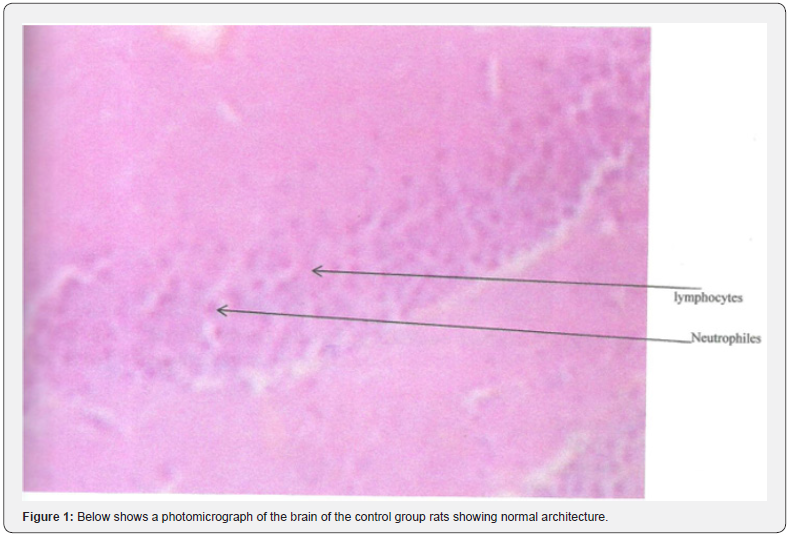
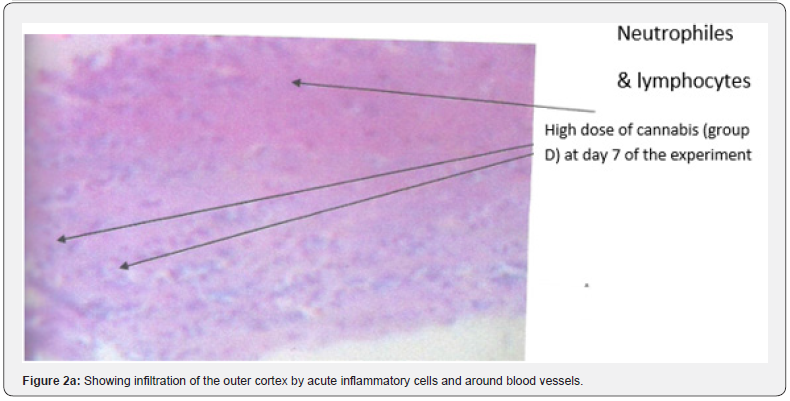
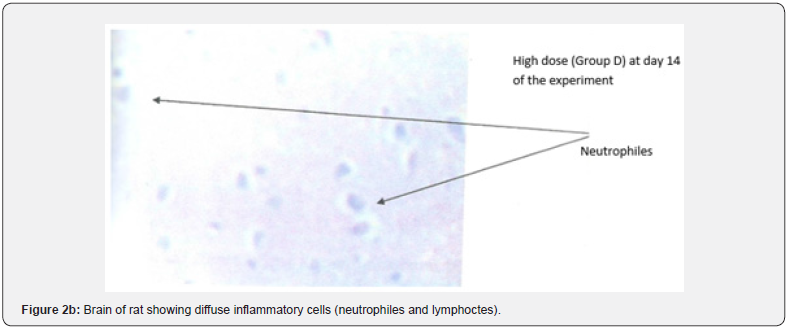
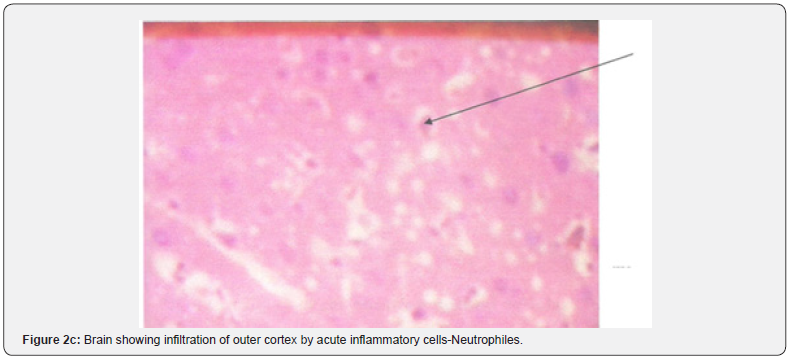
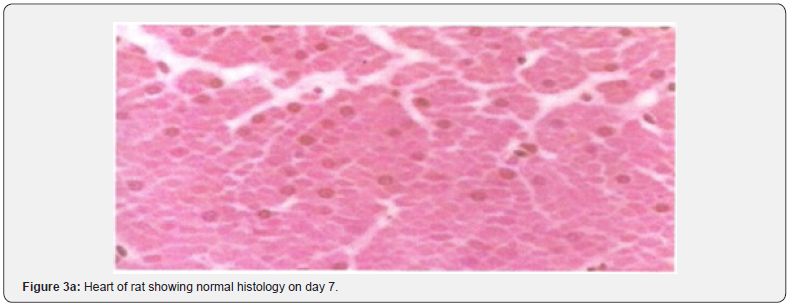


Discussion
This study was undertaken to determine, if in the addition to the usual intoxication, euphoria, and the feeling of “high” experienced by the users of cannabis, there are other structural changes caused by substance in some organs in the body and also to find any associated dose dependency effects. The organs studied include the brain, heart, liver and kidneys. Surveys have shown that marijuana is the most commonly used illicit drug world-wide (Kessler et al.1994). Several studies done on the effects of cannabis used have limited themselves mainly to the central nervous system (CNS) effects of this psychoactive substance. Despite the overwhelming results of the CNS effects such as changes in mood, perception, motivation, the “high” and “mellowing out”, incordination, impairment in learning and memory, there is as yet no convincing evidence that marijuana use damages brain cells or produces any permanent functional changes, Hubbard [16] although there are animal data indicating impairments of maze learning that persists for weeks after the last dose. (The Report of the National Commission on Marijuana Drug Abuse; Effect of long-term cannabis use, 2007). In this study, the oral route was preferred to inhalation because of dosage administration. Also in humans, oral ingestion of cannabis has been found to cause episodes of anxiety particularly panic and hallucination in about 50% to 60% than smoked marijuana Smoking produces a rapid onset of action and permits the set regulation of dose according to effect Also oral method of cannabis use seems to be increasing as most people use it to cook various dishes. The results of this study show that the animals which received cannabis showed increased aggression, violence and restlessness within- 30 minutes to 1 hour after intake of drugs. This effect was directly proportional to the dose of cannabis and declined to marked slowness and sluggish signs and excessive sleepiness in the last one week of the study. This suggests probably the onset of the most controversial a motivational syndrome.
This finding is consistent with the work of Tenant and Groesbeck. (Tenant S, Groesbeck D, 1972; Hall et al, 1994; Andrews J, 2001). The limbic system controls emotions (aggression, violence, anger, and rage) m human and it bears great deal of similarity with that of rat Stimulation of this centre therefore by engaging CBI and CB2 by the cannabis substance is thought to be responsible for the observed aggression, violence, restlessness, intoxication and the “high” that were observed in these animals Same explanation goes to similar effects seen in humans who consume cannabis and most other psychoactive substances like cocaine, PCP, LSD, opoid etc. Previous findings from Broyd [40]; Cohen [41] also revealed that impairment of executive function in synthetic cannabinoid users compared with recreational users of cannabis and non-users. Yucel et al. (2016) reported a decrease in hippocampal volumes following cannabis. Report from Beale [43] reported restorative effect of CBD on the subventricular and CA1 subfields in current cannabis users, especially those with greater lifetime exposure to cannabis. Awolabi [32] reported that cannabis exposure results in altered individual neurons morphologies and the spatial distribution of the cells in the Cornu Ammonis and dentate gyrus at higher concentration. Despite, numerous studies on cannabis on cognitive and hippocampus architectures, there are limited study on the effect of cannabis on the hippocampus on animal model in this research sphere. The study revealed increased appetite in the experimental animals with corresponding weight gains See Table 1. This is consistent with several studies (Binitie A, 1988; Odejide AO, 1980; Odegide AO, Sanda OA, 1976). However, it was observed that there was a progressive weight loss in the experimental animals in the last one week of the experiment. This may probably suggest that with prolonged use of cannabis, despite the munchies, there is gradual reduction in the rate of weight gains.
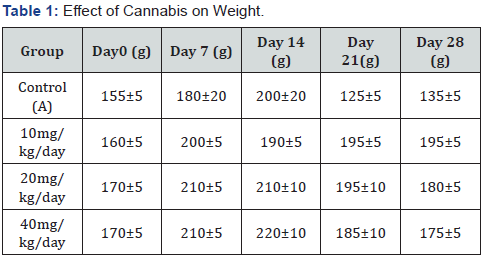
The mechanism of weight gain is thought to be due to stimulation of the CB 1 receptors in the ventrornedial area of the hypothalamus. Receptor desensitization may be responsible for the weight loss observed later in the experimental animals. Note that this was marked in the experimental animals on the highest dose of cannabis (40mg/kg/day), indicating a possible dose dependency effect. A dose dependent intoxication effect was observed in the experimental animals following each administration of cannabis probably due to the high”. This is consistent with many other earlier works that administration or consumption of large doses of cannabis causes acute intoxication (Andrew J.,2001). The histological findings revealed, in the animal that were dissected abnormality in the brain of the experimental animal which was chattered by infiltration of the outer cortex, meninges, choroids plexuses and blood vessels with acute inflammatory cells. This finding, however, was not consistent as it was only seen in about 0.2% of the experimental animals. It is thought that the impairment in cognitive function may be due to this inflammation. There is no literature on histological alteration of the brain with cannabis use, however, some of the toxicological studies have indicated that brain damage characterized by enlarged ventricles, damage to hippocampus and amygdale may all occur (Gbose D 1978) [44]. It has been suggested that most of the symptoms seen with cannabis psychosis like hallucinations and paranoia may be due to these structural changes. Also, Gbanai et al in 2008 noted that the wide therapeutic index is largely due to the fact that cannabis can bind with mirage of receptors, has prolonged half - life and can also accumulate in the tissue for a long time. Although the physiological functions of the CB receptors and their endogenous legends are incompletely understood, they are likely to mediate most of the CNS effects of cannabis [45,46]. This is because they are widely distributed with high densities in the cerebral cortex, hippocampus, striation and cerebellum (Iversen, 2003). For instance the effect on the hippocampus and other parts of the limbic systems produce the impaired memory and learning and possibly “high” and intoxication.
Although there is in obvious cannabis induced movement disorder, the subtle incoordination and a staggering movement which may accompany intoxication supports the wide receptor distribution in the cerebral cortex, striatum and the cerebellum. These are areas in the brain that control both voluntary and involuntary movement [47,48]. Specific CB antagonists have been developed and are in controlled clinical trials. One of these, rimonabant, has been reported to reduce relapse in cigarette smokers and to produce weight loss in obese patients (Gilman and Goodman, 2008 ed). An attempt to investigate any toxic effect of cannabis on the histology of the heart was born out of established strong relationship between cannabis use and panic disorder and because the later has been associated with various cardiac abnormalities particularly mitral valve prolapse. However, many people have argued that it may be the panic attack itself due to the hyper dynamic states it induces. In the study, no histological abnormality was found in the heart of all the animal that received cannabis. This may probably support earlier claims that cardiac abnormalities are most likely at high prolonged doses of cannabis. (Stimmel, B., 1979).
Conclusion
This study showed no structural changes in the heart after administration of cannabis for the study period. This may suggest that although cannabis has been strongly associated with panic attack and other cardiovascular effects, it may not cause any structural damage to the heart membrane, musculature and vasculature. However, the study has revealed that, in addition to issues of intoxication, cannabis can also produce histopathological damage to the brain [49,50]. It is therefore recommended that in addition to advice based on intoxication as reasons for abstinences, possible damage to brain tissues should also be given as reasons for abstinence and furthermore treatment of cannabis abuse should also involve possible investigations and treatment of brain damage.
Recommendations
From the observations and results from this study, it’s become appropriate to make the following recommendations.
i. Abusers of cannabis should abstain from the psychoactive substance as it is capable of causing structural damage(s) to such organs like the brain, liver, and kidney.
ii. In treatment of patient with cannabis abuse should necessarily involve appropriate investigations and treatment of these organs studied may be unique to the patient.
iii. The health sector, government as well as nongovernmental organizations should increase awareness and advocacy campaign about the inherent danger as well as the need to abstain from cannabis consumption.
iv. Such campaign should be focused on at-risk group like the youth, motor park drivers, secondary as well as university students.
v. The already existing legislations by the NDLEA and other law enforcement agencies, prohibiting the cultivation, handling and supply as well as smoking of cannabis should be well structured.
- Research Article
- Abstract
- Introduction
- Objectives
- Methodology
- Results
- Discussion
- Conclusion
- Recommendations
- References
References
- Adamson T (2005) Prevalence of Cannabis use among undergraduates in a Nigerian University: Drug Abuse Journal of Nigeria.
- Ashton CH (2001) Pharmacology and effects of cannabis: a brief review. Br J Psychiatry 178: 101-106.
- Berham O, Katzung, (2001) Basic and Clinical Pharmacology. 8th Edition: McGraw-Hill Companies, Inc USA pp: 542-544.
- Rajput R, Kumar K (2018) A review on cannabis sativa: Its compounds and their effects’, International Journal of Pharmaceutical Sciences Review and Research 53(2): 59-63.
- Akinola O (2019) Effects of whole Cannabis sativa ingestion on behavioural patterns and oxidative stress in mice brain tissues, Animal Research International 16(1): 3273-3284.
- Thornicroft G (1990) Cannabis and Psychosis in the epidemiological evidence of association. Br J Psychiatry, 157: 25-33.
- Boroffka (1996) Mental Illness and Indian hemp in Lagos, Nigerian. East Afr Med J 43(9): 377-384.
- Louise A, Mary C, Richie P, Robin M, Avshalom C (2002) “Cannabis use in adolescence and risk for adult psychosis: longitudinal prospective study British Medical Journal 325(7374): 1212-1213.
- Patton GC, Coffey C, Carlin JB, Degenhardt L, Lynskey M, Hall w (2002) Cannabis use and mental health in young people: cohort study.
- Odejide AO (2003) Prevalence of psychoactive substance use in Nigeria. A review of the existing literature and suggestions on preventive measures Nigerian Medical Journal 15: 35-40.
- Stanley PC, Eneh AU (2004) Pattern of Substance use among Secondary School Students in Rivers State. Niger J medicine 13(1): 36-39.
- MacFadden w, woody G.E Cannabis-related disorders. In: Sadock BJ Sadock VA, eds. Kaplan & Sadock’s comprehensive textbook of Psychiary 7th ed. Vol.1 Baltimore: lippincott Williams & Wilkins 2009: 990.
- Zou S, Kumar U (2018) ‘Cannabinoid receptors and the endocannabinoid system: Signaling and function in the central nervous system’, International Journal of Molecular Sciences. MDPI AG.
- Blanchard Radndall (1992) Medical use of Marijuana policy and Regulatory Issues, library of congress, congressional Research Service.
- Gurley RJ, Aranow R, Katz M (1998) Medicinal marijuana: a comprehensive review. J Psychoactive Drugs 30(2): 137-147.
- Hubbard JR, Franco SE, Onaivi ES (1999) Marijuana: Medical Implication. December 1999-American Academy of Family Physicians.
- Obot IS (1993) Epidemiology and control of substance abuse in Nigeria; Centre for Research and Information on substance abuse. (CRISA) Jos.
- Munro S, Thomas KL, Abu-Shaar M (1993) Molecular characterization of a peripheral receptor for cannabinoids. Nature 365: 61-65.
- Ujah A (2014) Phytochemical, proximate composition, amino acid profile and characterization of Marijuana (Cannabis sativa L).
- Hillig KW, Paul GM (2004) A chemotaxonomic analysis of Cannabinoid variation in Cannai (Cannabaceae) Am J Bot 1(6): 966-975.
- Audu Sambo B Audu BS, Ofojekwu PC, Ujah A, Ajima MNO (2014) Phytochemical, proximate composition, amino acid profile and characterization of Marijuana (Cannabis sativa L.) The Journal of Phytopharmacology 3(1): 35-43.
- Oladimeji AV, Valan M (2020) Phytochemical profile of cannabis plant: A review, Journal of Pharmacognosy and Phytochemistry 9(3): 680-687.
- Choudhary N (2013) Phytochemical aspect of Cannabis sativa (L.), Research Journal of Science and Technology 5(2): 284-288.
- Onaivi ES, Chakrabarti A, Chaudhuri O (1996) Cannabinoid receptor genes. Prog Neurobiol 48 (4-5): 275-305.
- Schweitzer P, Stella N, Piomelli D (1997) A second endogenous cannabinoid that modulates long-term potentiation. Nature 388(6644): 773-778.
- Pertwee RG (2010) International Union of Basic and Clinical Pharmacology. LXXIX. Cannabinoid receptors and their ligands: Beyond CB1 and CB2, Pharmacological Reviews. Pharmacol Rev 62(4): 588-631.
- Chen DJ (2017) Brain cannabinoid receptor 2: Expression, function and modulation, Acta Pharmacologica Sinica 38(3): 312-316.
- Rodrigues RS (2019) Cannabinoid actions on neural stem cells: Implications for pathophysiology, Molecules 24(7): 1350.
- Chait LD, Zacny JP (1992) Reinforcing and subjective effects of oral delta 9- THC and smoked marijuana in humans. Psychopharmacology 107(2-3): 255-262.
- Gardner El, Lowinson JH (1991) Marijuana’s interaction with brain reward systems: update 1991. pharmacol Biochem Behav 40(3): 571-580.
- Cohen K, Weinstein A (2018) The effects of cannabinoids on executive functions: Evidence from cannabis and synthetic cannabinoids—a systematic review, Brain Sciences. MDPI AG.
- Awolabi J (2017) Histomorphological Aberrations Associated with Cannabis and Caffeine Exposure in the Hippocampus of Juvenile Wistar Rats, International Neuropsychiatric Disease Journal. Science domain International 9(4): 1-10.
- Blanchard R (1992) Medical use of Marijuana policy and Regulatory Issues, library of congress, congressional Research Service.
- Hollister LE (1998) Health aspects of cannabis: revisited, Intern J Neuropsychopharmacology 1(1): 71-80.
- Hangmen Jiang (2006) A new insight into Cannabis sativa (annabaceae) utilization from 250-year-old.
- Booth, Martin (2005) Cannabis: A History ISBN 0-312-32220-8.
- Ainsworth C (2000) Boys and girls come out to play: the molecular biology of dioecious plants Annals Botany 86(2): 211-221.
- Anthony JC, Heizer JE (1991) Syndromes of drug abuse and dependence. In Psychiatric Disorder in America (ed 1st. Robins N and Regier DA) New York: Free Press, Macmillian.
- Beautrais AL, Joycee PR (1999) Cannabis Abuse and serious suicide attempts Addiction 94(8): 1155-1164.
- Broyd SJ (2016) Acute and chronic effects of cannabinoids on human cognition - A systematic review’, Biological Psychiatry 79(7): 557-567.
- Cohen K (2017) The effects of synthetic cannabinoids on executive function’, Psychopharmacology 234(7): 1121-1134.
- Friedman H, Klein TW, Newton C, Daaka Y (1995) Marijuana, receptors and immunomodulation, Adv Exp Med Biol 373: 103-113.
- Beale C (2018) Prolonged cannabidiol treatment effects on hippocampal subfield volumes in current cannabis users, Cannabis and Cannabinoid Res 3(1): 94-107.
- Curran HV (2002) Cognitive and subjective dose-response effects.
- Cantwell R, Brewin J, Glaze brook C (1999) Prevalence of substance misuse in first-episode psychosis Br J Psychiatry 174: 150-153.
- Lowinson JH, Ruiz P, Millman RB (1992) Marijuana. In: Substance abuse: a comprehensive textbook 2nd Baltimore, Md: Williams and Wilkins p. 17.
- McKim, William A (2002) Drugs and Behavior: An Introduction to Behavoiral Pharmacology (5th Edition). Prentice Hall pp. 400.
- Murphy LL, Steger RW, Bartke A (1994) Effects of delta 9- tetrahydrocannabinol on copulatory behaviour and neuroendocrine responses of male rats to female conspecifics. Pharmacol Biochem Behave 48(4): 1011-1017.
- Hangmen Jiang (2006) A new insight into Cannabis sativa (annabaceae) utilization from 250-year-old.
- Owolabi J (2017) Histomorphological Aberrations Associated with Cannabis and Caffeine Exposure in the Hippocampus of Juvenile Wistar Rats’, International Neuropsychiatric Disease Journal. Sciencedomain International 9(4): 1-10.






























